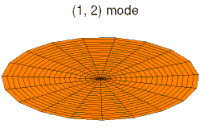
Photo from wikipedia
Abstract Composite beams are increasingly used in aerospace, automobile, and other applications. Crack is the most common defect in structures during its service life. The cracked composite beams are subjected… Click to show full abstract
Abstract Composite beams are increasingly used in aerospace, automobile, and other applications. Crack is the most common defect in structures during its service life. The cracked composite beams are subjected to dynamic loads and the vibration of the cracked beams is of technical significance to the structural integrity of systems. The objective of the present investigation is to demonstrate the vibration characteristics of a laminated composite beam (LCB) with multiple transverse cracks. Finite element method (FEM) is used for the frequency-based crack analysis in this study. A computer program is developed in MATLAB environment for numerical analysis. First-order shear deformation theory (FSDT) is adopted for the finite element analysis. Natural frequencies of vibration are computed through the eigenvalue solver. Composite specimens are fabricated using hand lay-up technique and are tested for its material constants under tensile test. Experiments are conducted using woven roving Glass/Epoxy laminated beam samples with pre-defined cracks. The obtained test results from the experimental work using FFT analyzer are validated with the numerical results obtained through MATLAB. The effects of natural frequencies with respect to the various boundary conditions, crack depth and locations are investigated to support in real applications. A fine agreement is accomplished between the numerical and test results. Both the studies showed that natural frequencies in the LCB are significantly influenced by the location and size of the cracks. The results show that natural frequencies are decreased with cracks and an increase in fiber orientation.
Journal Title: Mechanical Systems and Signal Processing
Year Published: 2020
Link to full text (if available)
Share on Social Media: Sign Up to like & get
recommendations!